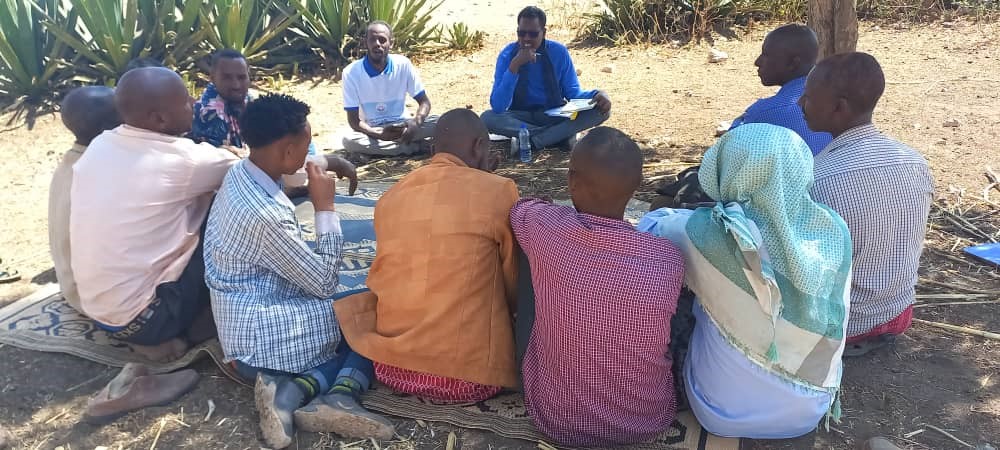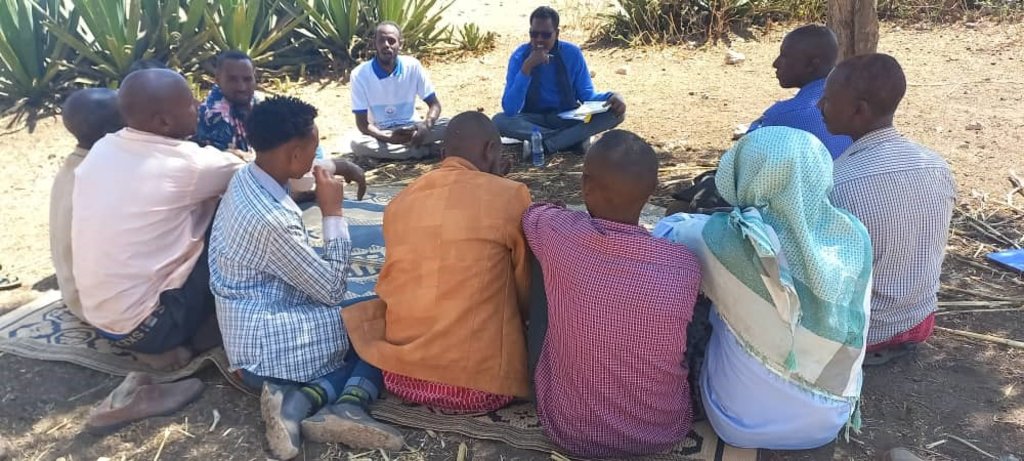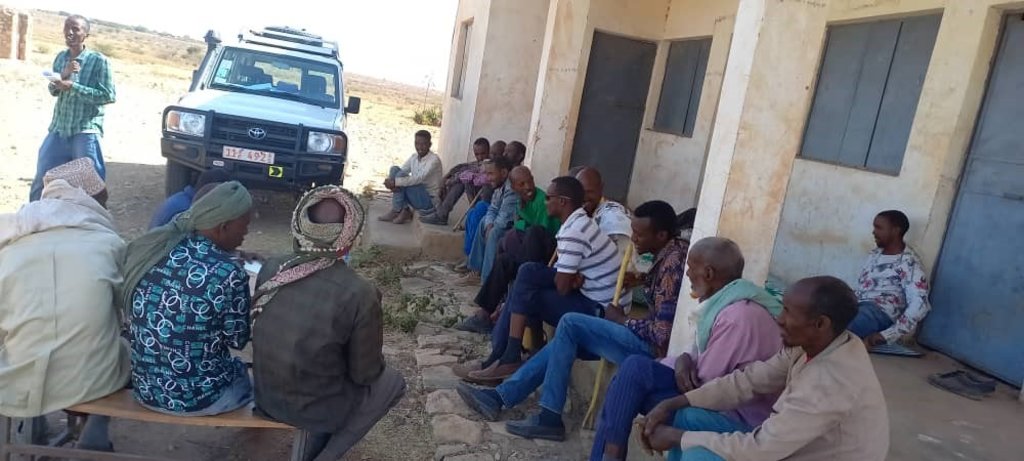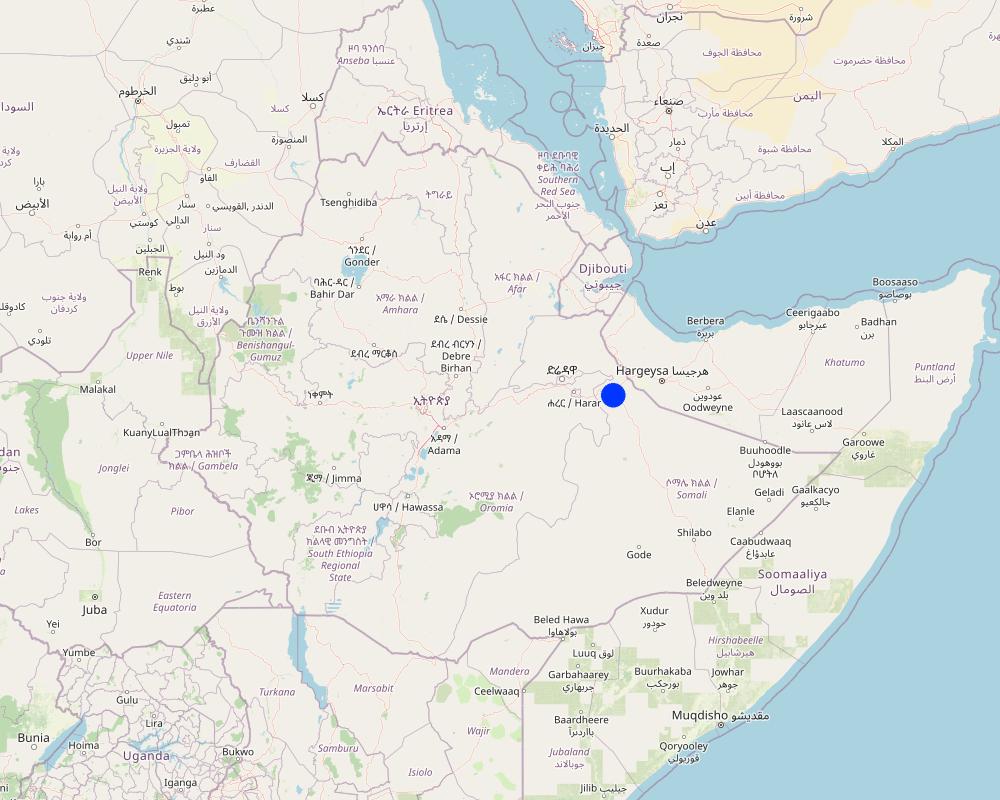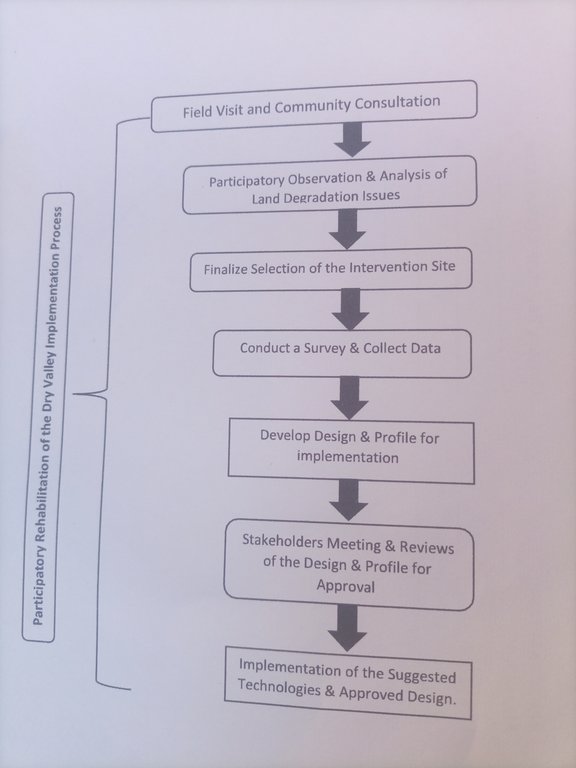Participatory Rehabilitation of Dry Valleys [Ethiopia]
- Creation:
- Update:
- Compiler: GERBA LETA
- Editors: Torben Helbig, Noel Templer, Tabitha Nekesa, Ahmadou Gaye, Siagbé Golli
- Reviewers: William Critchley, Rima Mekdaschi Studer, Sally Bunning
Kaqayb Galka Dadwayne
approaches_6718 - Ethiopia
View sections
Expand all Collapse all1. General information
1.2 Contact details of resource persons and institutions involved in the assessment and documentation of the Approach
Key resource person(s)
SLM specialist:
Omer Ahmed
+251910061493
ahmdomr1954@gmail.com
Natural Resource Department of Somali Regional State Bureau of Agriculture
Somali Regional State, JigJiga
Ethiopia
Name of project which facilitated the documentation/ evaluation of the Approach (if relevant)
Soil protection and rehabilitation for food security (ProSo(i)l)Name of the institution(s) which facilitated the documentation/ evaluation of the Approach (if relevant)
Alliance Bioversity and International Center for Tropical Agriculture (Alliance Bioversity-CIAT) - Kenya1.3 Conditions regarding the use of data documented through WOCAT
When were the data compiled (in the field)?
22/03/2023
The compiler and key resource person(s) accept the conditions regarding the use of data documented through WOCAT:
Yes
1.4 Reference(s) to Questionnaire(s) on SLM Technologies
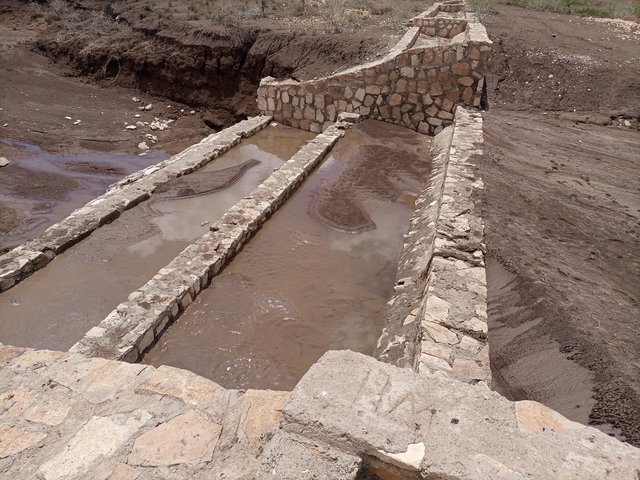
Double Basin Masonry Check Dam [Ethiopia]
A double basin masonry check dam is a physical structure that helps to stop gully formation or further development of gullies in dry valleys. It rehabilitates small to a medium-sized deep gullies that are eating into the heart of adjacent land.
- Compiler: GERBA LETA
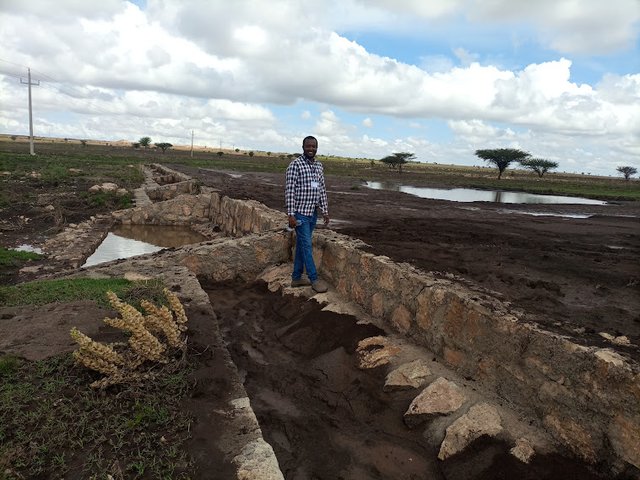
Water Spreading Weirs [Ethiopia]
Water Spreading Weirs are designed to protect the degradation of agricultural fields and rangelands. They contribute to soil and water conservation and enhance the productive use of dry valleys for food crops and livestock fodder production via the harvest and spread of runoff water and fertile soils.
- Compiler: GERBA LETA
2. Description of the SLM Approach
2.1 Short description of the Approach
Participatory rehabilitation and productive use of dry valleys is an approach employed to rehabilitate degraded and degradable land. It is operationalised through the Lowland Soil Rehabilitation Project with local development partners from kebele, district, regional agricultural bureaus, and other relevant stakeholders.
2.2 Detailed description of the Approach
Detailed description of the Approach:
Participatory rehabilitation of degraded and degradable dry valleys engages the community at the grassroots through consultation. It is operationalised through the Lowland Soil Rehabilitation Project with local development partners from kebele, district, regional agricultural bureaus, and other relevant stakeholders.
Technical experts from the district and region are involved in reconnaissance, observation and joint selection of the intervention sites. The team conduct a survey, then profile and design the technologies required, along with the project engineer. The approach optimises the participation of the community and agricultural actors, allowing the development of a sense of ownership and accountability through training and awareness-creation exercises. In turn this encourages them to take care of and maintain the structures.
This approach combines top-down and bottom-up methods. At the grassroots, the local agropastoral communities are mobilized by local extension agents and made aware about the SLM intervention that the project and partners strive to put in place – including the physical structures in the farmers' fields and communal lands. The procedures include a site visit, a survey/ observation, and the identification of the intervention site based on the specific topographic features and drainage system of the catchment. Then, detailed field data is collected and a profile analysis is made to develop the design and get approval after stakeholders’ consultation and review of the details of the implementation design. The approach is complemented by satellite imagery and ground truthing. Following this, the next stage is identification of masonry experts, provision of training, and supply of construction materials and tools. Building the masonry works involves both skilled and unskilled labour.
The woreda NRM expert (focal person) facilitate the process at the grassroots through the development agents. The community gives their consent and support to the objectives of the project implementation. Therefore, they are involved in local decision-making and overseeing the technology that is being put in place.
The agropastoral community is the end user and benefits from the positive consequences of the intervention which is a result of better management of soil and water for productive uses of the dry valley. However, because of a lack of awareness, and the agropastoralists conventional livelihoods practice traveling with their livestock, there is a lack of participation in the day-to-day implementation activities. That limits their active contribution in implementation. Of course, local elders value the consultative experience which confirms a sense of self-worth and acknowledges their role in ownership of the land and as the ultimate decision-maker for development intervention operating in their areas.
2.3 Photos of the Approach
General remarks regarding photos:
Photos (undated) obtained from project staff of community engagement taking place at the beginning of the project implementation.
2.4 Videos of the Approach
Comments, short description:
Video of the approach was not documented.
2.5 Country/ region/ locations where the Approach has been applied
Country:
Ethiopia
Region/ State/ Province:
Somali
Further specification of location:
Amadle kebele, South Jijiga district
Map
×2.6 Dates of initiation and termination of the Approach
Indicate year of initiation:
2021
Comments:
The project termination date is not indicated.
2.7 Type of Approach
- project/ programme based
2.8 Main aims/ objectives of the Approach
To engage the community and other stakeholders in making participatory decisions on the rehabilitation of the dry valley.
2.9 Conditions enabling or hindering implementation of the Technology/ Technologies applied under the Approach
availability/ access to financial resources and services
- enabling
Access to finance promotes intensive awareness creation and participation of the community to implement the technology at a larger scale. Also, it allows supporting the maintenance and other follow on actions that ensure sustainability.
institutional setting
- enabling
Setting up the local institution such as an agropastoralist group enables the effective implementation of dry valley rehabilitation technologies/practices.
collaboration/ coordination of actors
- enabling
Coordination of actors enables the identification of useful actors and cross-fertilize experiential knowledge for documentation and further uses. Also, it enables acknowledgment of the contribution of different actors.
knowledge about SLM, access to technical support
- enabling
Having SLM knowledge enables efficient and effective implementation of dry valley rehabilitation technologies.
workload, availability of manpower
- enabling
Labour in the agropastoralist area is the limiting factor for the effective implementation of SLM practices. Therefore, the availability of labor or manpower is pivotal for the proper implementation of the SLM.
3. Participation and roles of stakeholders involved
3.1 Stakeholders involved in the Approach and their roles
- local land users/ local communities
Agropastoralist.
Participatory planning and decision making, sources casual laborer and oversee the technologies/practices.
- SLM specialists/ agricultural advisers
Natural Resource Management experts.
Facilitate stakeholders' participation, provide technical support, and backstopping services, and monitor the development during and after the implementation of the technologies.
- private sector
Contractor to perform the engineering works.
Building/constructing the physical structures.
- GIZ project
GIZ (bilateral cooperation) projects.
Provide financial and technical support to the government partner organizations to promote the proper implementation of the rehabilitation of dry valley.
3.2 Involvement of local land users/ local communities in the different phases of the Approach
| Involvement of local land users/ local communities | Specify who was involved and describe activities | |
|---|---|---|
| initiation/ motivation | interactive | Agropastoralists involve in allowing peers to understand SLM-related intervention. |
| planning | interactive | Land users involve in participatory planning and decision-making exercise. |
| implementation | external support | Skilled and unskilled laborers are sources from neighboring urban areas and the intervention kebeles. |
| monitoring/ evaluation | external support | SLM experts and extension agents support in monitoring and evaluation of the intervention activities. |
3.3 Flow chart (if available)
Description:
The sketch describe the process of implementing Participatory Rehabilitation of Dry Valleys.
Author:
Gerba Leta
3.4 Decision-making on the selection of SLM Technology/ Technologies
Specify who decided on the selection of the Technology/ Technologies to be implemented:
- mainly SLM specialists, following consultation with land users
Explain:
The communities are consulted, however, selection decision is made by the SLM experts of the partner organizations in consultation with the project SLM specialists.
Specify on what basis decisions were made:
- evaluation of well-documented SLM knowledge (evidence-based decision-making)
4. Technical support, capacity building, and knowledge management
4.1 Capacity building/ training
Was training provided to land users/ other stakeholders?
Yes
Specify who was trained:
- field staff/ advisers
Form of training:
- on-the-job
- public meetings
Form of training:
- Masonry workers
Subjects covered:
Dry Land Rehabilitation and Produce Use of the rehabilitated land. Basically, the training is on the SLM practices which are suitable for agropastoralist areas with special emphasis on the physical structure.
Comments:
SLM experts from partner organizations and masonry workers were trained to assist in the implementation of SLM practices for dry land rehabilitation.
4.2 Advisory service
Do land users have access to an advisory service?
Yes
Specify whether advisory service is provided:
- on land users' fields
Describe/ comments:
Advisory services related to SLM are infrequently given. As the agropastoralists are mobile looking for feed and water, particularly during the dry period, advisory services have not been provided on regular basis.
4.3 Institution strengthening (organizational development)
Have institutions been established or strengthened through the Approach?
- yes, a little
Specify the level(s) at which institutions have been strengthened or established:
- local
Describe institution, roles and responsibilities, members, etc.
Stakeholders from government and bilateral organization (project) do make ad hoc meeting during planning and evaluation, this brings actors together but need to establish a sustainable institution that stands on its own and can be working beyond the project's lifetime. Particularly, a land users (agropastoralist) group is essential to oversee the technology placed on their land so that sustainability of the intervention can be ensured.
Specify type of support:
- financial
- capacity building/ training
- equipment
Give further details:
The equipment refers to the technical tools that can be used by the partner experts - but not farm tools. The latter is expected during which the agropastoralist resumes the productive use of the rehabilitated land which is currently in the initial years of implementation and not yet associated with the productive uses of it.
4.4 Monitoring and evaluation
Is monitoring and evaluation part of the Approach?
Yes
Comments:
The monitoring and evaluation are part of the project implementation that enables the implementers to track the development and engage the end users to enable them to sense the benefits. The land users started to benefit from the structure such as fetching drinking water both for human and their livestock, though, it is an indirect benefit from the intervention.
If yes, is this documentation intended to be used for monitoring and evaluation?
Yes
4.5 Research
Was research part of the Approach?
No
5. Financing and external material support
5.1 Annual budget for the SLM component of the Approach
If precise annual budget is not known, indicate range:
- 2,000-10,000
Comments (e.g. main sources of funding/ major donors):
No specific data on budget allocation for SLM at the district level. However, Local Subsidy Contract (LSC) was used to assist the woreda implement and follow-up the development of the intervention.
5.2 Financial/ material support provided to land users
Did land users receive financial/ material support for implementing the Technology/ Technologies?
No
5.3 Subsidies for specific inputs (including labour)
Comments:
There is no subsidy system supplied to the land users. Labor contribution is on a pay basis in cash. As the area is characterized by food insecurity and drought-prone by virtue, free labor is not expected. Basically, skilled and unskilled labor imported from the nearby town. Thus, it is impossible to assign this role to the land users.
5.4 Credit
Was credit provided under the Approach for SLM activities?
No
5.5 Other incentives or instruments
Were other incentives or instruments used to promote implementation of SLM Technologies?
No
6. Impact analysis and concluding statements
6.1 Impacts of the Approach
Did the Approach empower local land users, improve stakeholder participation?
- No
- Yes, little
- Yes, moderately
- Yes, greatly
Local land users consulted and informed regarding the benefits of SLM for the degraded and potentially degradable lands to ensure rehabilitation and its productive use. This may give motivation and a sense of self-worth as land owner.
Did the Approach enable evidence-based decision-making?
- No
- Yes, little
- Yes, moderately
- Yes, greatly
Beyond the approach, the land users can learn from the actual function of the technologies.
Did the Approach help land users to implement and maintain SLM Technologies?
- No
- Yes, little
- Yes, moderately
- Yes, greatly
Consultation with the land users motivates them to build trust in the intervention.
Did the Approach improve coordination and cost-effective implementation of SLM?
- No
- Yes, little
- Yes, moderately
- Yes, greatly
In the long run, it can assist land users mobilize casual laborers.
Did the Approach mobilize/ improve access to financial resources for SLM implementation?
- No
- Yes, little
- Yes, moderately
- Yes, greatly
Did the Approach improve knowledge and capacities of land users to implement SLM?
- No
- Yes, little
- Yes, moderately
- Yes, greatly
The approach creates an opportunity for land users to engage in the initial implementation process through which their awareness is raised.
Did the Approach improve knowledge and capacities of other stakeholders?
- No
- Yes, little
- Yes, moderately
- Yes, greatly
Through stakeholders meeting and training opportunities created by the project.
Did the Approach build/ strengthen institutions, collaboration between stakeholders?
- No
- Yes, little
- Yes, moderately
- Yes, greatly
It builds collaboration between stakeholders.
Did the Approach mitigate conflicts?
- No
- Yes, little
- Yes, moderately
- Yes, greatly
Did the Approach empower socially and economically disadvantaged groups?
- No
- Yes, little
- Yes, moderately
- Yes, greatly
Involve them in the awareness creation training.
Did the Approach improve gender equality and empower women and girls?
- No
- Yes, little
- Yes, moderately
- Yes, greatly
Women are involved in the community meeting and/or consultation. Also benefited from the technology as it creates the opportunity to fetch drinking still water closer to their residence.
Did the Approach encourage young people/ the next generation of land users to engage in SLM?
- No
- Yes, little
- Yes, moderately
- Yes, greatly
It provides knowledge to the young generation through exposure to evidence based intervention.
Did the Approach improve issues of land tenure/ user rights that hindered implementation of SLM Technologies?
- No
- Yes, little
- Yes, moderately
- Yes, greatly
Did the Approach lead to improved food security/ improved nutrition?
- No
- Yes, little
- Yes, moderately
- Yes, greatly
The technology implemented using the participatory approach believed to rehabilitate degraded lands and enhances productive use of the rehabilitated lands for growing various crops, and supply feeds to the livestock.
Did the Approach improve access to markets?
- No
- Yes, little
- Yes, moderately
- Yes, greatly
Did the Approach lead to improved access to water and sanitation?
- No
- Yes, little
- Yes, moderately
- Yes, greatly
The technology implemented using this approach creates land users temporal access to still as well as groundwater regardless.
Did the Approach lead to more sustainable use/ sources of energy?
- No
- Yes, little
- Yes, moderately
- Yes, greatly
Did the Approach improve the capacity of the land users to adapt to climate changes/ extremes and mitigate climate related disasters?
- No
- Yes, little
- Yes, moderately
- Yes, greatly
In the future, when the productive use of dry valley is effected, post the rehabilitation efforts, land users certainly develop an adaptation to climate change and associated disasters through participatory approach.
Did the Approach lead to employment, income opportunities?
- No
- Yes, little
- Yes, moderately
- Yes, greatly
It improves generation of income from the production of food and feed crops.
6.2 Main motivation of land users to implement SLM
- increased production
Food crops and livestock feed production are increased as the technology reduces the intensity and effects of erosion and conserves soil and water.
- increased profit(ability), improved cost-benefit-ratio
Over time, the technology/approach improves the productive use of rehabilitated land for crop and livestock production that increases overall benefits.
- reduced land degradation
As the structure stops heavy movement of the soil with runoff, it absolutely reduces the rate or speed of erosion and land degradation.
- reduced risk of disasters
The water harvested and spread on the farmland reduces the risks of crop failure and can be used for spate irrigation. Furthermore, the structure reduces the speed of runoff and retain the top soil moving away.
- enhanced SLM knowledge and skills
The exposure to training and collective action and lesson learnt from the outcome of the implementation enhance knowledge and skills of the land users and experts.
6.3 Sustainability of Approach activities
Can the land users sustain what has been implemented through the Approach (without external support)?
- uncertain
If no or uncertain, specify and comment:
As maintenance of the structure such as in cases of check dam is resource demanding, it is less likely for the land users to maintain/repair on their own. Rather early combining the physical structure by biological barriers or perennial forage or tree planation may ensure sustainability of the technology/land use. Furthermore, it demands time and labor from the agro-pastoralists.
6.4 Strengths/ advantages of the Approach
| Strengths/ advantages/ opportunities in the land user’s view |
|---|
| Creates stakeholders awareness on SLM, and productive use of rehabilitated dry valley. |
| Improves coordination between agricultural actors in line offices, and other stakeholders collective action. |
| Enhances participatory decision making on the development and use of the rehabilitated lands. |
| Strengths/ advantages/ opportunities in the compiler’s or other key resource person’s view |
|---|
| It creates evidence based lesson learning to replicate similar practices across the region. |
| It improves SLM implementation capacity of the development partners (agricultural offices) and the land users at local level. |
| It encourages the government respective department to allocate matching fund for SLM operationalized by development partners. |
6.5 Weaknesses/ disadvantages of the Approach and ways of overcoming them
| Weaknesses/ disadvantages/ risks in the land user’s view | How can they be overcome? |
|---|---|
| Time and energy/labor demanding to integrate efforts of experts from different organizations. | Nurture proper joint planning for collective action. |
| Shortage of financial and material resources to put the structure in place. | Find and generate sources of resources and promote efficient use of the available budget. |
| Improper participation of stakeholders (dropout of experts) | Enforce participation through adopting binding by-laws to all. |
| Weaknesses/ disadvantages/ risks in the compiler’s or other key resource person’s view | How can they be overcome? |
|---|---|
| Recurrent droughts displace the land users while looking for water and feed to their animals. | Ensure representation to the community, and assess enabling environment that reduce temporal displacement of the land users. |
| Relatively low participation of the land users in the conception and implementation of the approach as well as the technology intended to rehabilitate the dry valley. | Promote land users participation through intensive capacity building and awareness creation by gender and various categories of the community. |
| Lack of forming agro-pastoralist group who are believed to share knowledge, skills and labor for collective oversee and maintenance of the technology when damage is encountered. | Promote the development of a local institution that allows not only for the use of the land but also to oversee the gaps, report the issues, and involve in participatory fixing activities. |
7. References and links
7.1 Methods/ sources of information
- field visits, field surveys
Three individuals
- interviews with SLM specialists/ experts
Four
7.2 References to available publications
Title, author, year, ISBN:
Problems and landscape approach for ecological rehabilitation in the dry valleys of Southwest China. Dong, Y. & Liu, S. (Undated)
Available from where? Costs?
https://www.researchgate.net/profile/Shiliang-Liu-5/publication/221354340_Problems_and_Landscape_Approach_for_Ecological_Rehabilitation_in_the_Dry_Valleys_of_Southwest_China/links/574129be08ae9ace84160bec/
7.3 Links to relevant information which is available online
Title/ description:
Supporting local planning and the importance of mapping
URL:
https://dream.vandermeijde.net/wp-content/uploads/2022/11/220620_planningandmapping_Roden.pdf
Links and modules
Expand all Collapse allLinks

Double Basin Masonry Check Dam [Ethiopia]
A double basin masonry check dam is a physical structure that helps to stop gully formation or further development of gullies in dry valleys. It rehabilitates small to a medium-sized deep gullies that are eating into the heart of adjacent land.
- Compiler: GERBA LETA

Water Spreading Weirs [Ethiopia]
Water Spreading Weirs are designed to protect the degradation of agricultural fields and rangelands. They contribute to soil and water conservation and enhance the productive use of dry valleys for food crops and livestock fodder production via the harvest and spread of runoff water and fertile soils.
- Compiler: GERBA LETA
Modules
No modules


